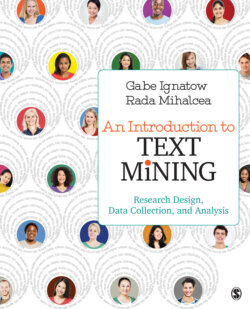Читать книгу An Introduction to Text Mining - Gabe Ignatow - Страница 12
На сайте Литреса книга снята с продажи.
Introduction
ОглавлениеText mining is an exciting field that encompasses new research methods and software tools that are being used across academia as well as by companies and government agencies. Researchers today are using text mining tools in ambitious projects to attempt to predict everything from the direction of stock markets (Bollen, Mao, & Zeng, 2011) to the occurrence of political protests (Kallus, 2014). Text mining is also commonly used in marketing research and many other business applications as well as in government and defense work.
Over the past few years, text mining has started to catch on in the social sciences, in academic disciplines as diverse as anthropology (Acerbi, Lampos, Garnett, & Bentley, 2013; Marwick, 2013), communications (Lazard, Scheinfeld, Bernhardt, Wilcox, & Suran, 2015), economics (Levenberg, Pulman, Moilanen, Simpson, & Roberts, 2014), education (Evison, 2013), political science (Eshbaugh-Soha, 2010; Grimmer & Stewart, 2013), psychology (Colley & Neal, 2012; Schmitt, 2005), and sociology (Bail, 2012; Heritage & Raymond, 2005; Mische, 2014). Before social scientists began to adapt text mining tools to use in their research, they spent decades studying transcribed interviews, newspaper articles, speeches, and other forms of textual data, and they developed sophisticated text analysis methods that we review in the chapters in Part IV. So while text mining is a relatively new interdisciplinary field based in computer science, text analysis methods have a long history in the social sciences (see Roberts, 1997).
Text mining processes typically include information retrieval (methods for acquiring texts) and applications of advanced statistical methods and natural language processing (NLP) such as part-of-speech tagging and syntactic parsing. Text mining also often involves named entity recognition (NER), which is the use of statistical techniques to identify named text features such as people, organizations, and place names; disambiguation, which is the use of contextual clues to decide where words refer to one or another of their multiple meanings; and sentiment analysis, which involves discerning subjective material and extracting attitudinal information such as sentiment, opinion, mood, and emotion. These techniques are covered in Parts III and V of this book. Text mining also involves more basic techniques for acquiring and processing data. These techniques include tools for web scraping and web crawling, for making use of dictionaries and other lexical resources, and for processing texts and relating words to texts. These techniques are covered in Parts II and III.
Research in the Spotlight
